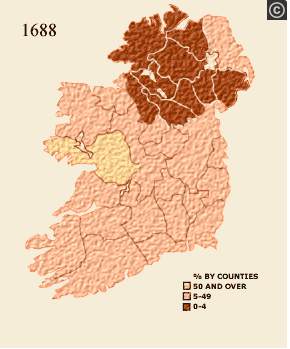After reading about Irish Penal Laws in Kilfeather’s book, the maps of Irish plantations took on a whole meaning for me. Before educating myself on this portion of Irish history, the maps simply outlined statistics. But I realized that there are much deeper social implications behind these color coded images.
The primary objectives behind these penal laws were to reduce Catholic Irish power and convert as many individuals to Protestantism as possible. The laws in place barred Catholics from sending their children abroad for education, prohibited inter-religious marriages, and attempted to oust the Catholic clergy. Naturally, when I was able to view the Irish plantation maps, this knowledge came to mind and shaped the way I viewed them. The first map depicted regions where Catholic ownership of land exceeded 50 percent. The year was 1641.

In 1688, the information on the map looked quite different. Catholic land ownership made up less than five percent of the area in 10 Irish counties. The Protestant conversion tactics were, as noted here, imperialistic and exploitative in practice.

These maps, however, while they physically mark the changing times, do not tell the whole story. The cultural clash between Catholics and Protestants produced palpable anxiety on both sides. These sentiments were reflected in the literature of the time. While Irish Catholics were eventually allotted at least partial relief, lingering resentments and animosities persisted. In the opening of Chapter Two in the book, the author says, “Walking around Dublin, one might gain the impression that in the eighteenth century there reigned in Ireland a particular harmony and prosperity that gave rise to some of the city’s greatest civic achievements.” However, she goes on to explain that this most certainly was not the case. The religious contrasts made for harsh laws and visible differences in Irish landscape and demographics.
